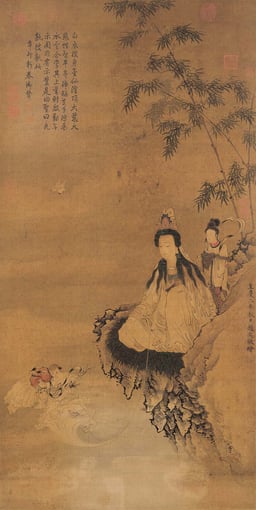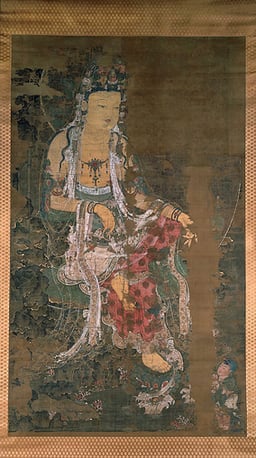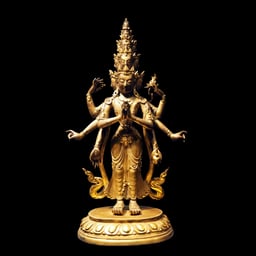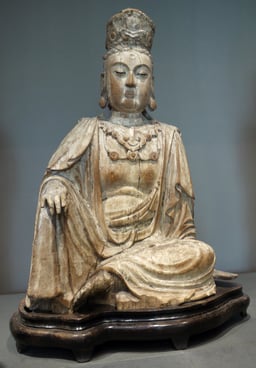Avalokiteśvara

Avalokiteśvara

| Avalokiteśvara | |
|---|---|
| Sanskrit | अवलोकितेश्वर (IAST: Avalokiteśvara) |
| Chinese | 觀自在菩薩, 觀世音菩薩 or 觀音菩薩 (Pinyin: Guānzìzài Púsà, Guānshìyīn Púsà or Guānyīn Púsà (Cantonese: Gun1 Zi6 Zoi6 Pou4 Saat3, Gun1 Sai3 Jam1 Pou4 Saat3 or Gun1 Jam1 Pou4 Saat3) |
| Japanese | (romaji: Kanjizai Bosatsu, Kanzeon Bosatsu or Kannon Bosatsu) |
| Khmer | អវលោកិតេស្វរៈ , អវលោកេស្វរៈ , លោកេស្វរៈ (Avalokitesvarak, Avalokesvarak, Lokesvarak) |
| Korean | 관세음보살/觀世音菩薩 (RR: Gwanseeum Bosal) |
| Mongolian | ᠨᠢᠳᠦ ᠪᠡᠷ ᠦᠵᠡᠭᠴᠢ |
| Thai | พระอวโลกิเตศวรโพธิสัตว์ ( Phra Avalokitesuan ) |
| Tibetan | སྤྱན་རས་གཟིགས་ Wylie: spyan ras gzigs THL: Chenrézik |
| Vietnamese | Quán Tự Tại Bồ Tát, Quan thế âm Bồ tát, Quan âm Bồ tát, Phật Bà |
| Information | |
| Venerated by | Mahayana, Vajrayana, Theravada*, Taoism, Chinese Folk Religion |
| Attributes | Compassion |
Avalokiteśvara or Padmapani (/ˌʌvəloʊkɪˈteɪʃvərə/ UV-əl-oh-kih-TAY-shvər-ə;[1] Sanskrit: अवलोकितेश्वर) is a bodhisattva who embodies the compassion of all Buddhas. This bodhisattva is variably depicted, described and portrayed in different cultures as either male or female.[2] In Tibet, he is known as Chenrezig, and in Cambodia as Avloketesvar. In Chinese Buddhism, Avalokiteśvara has evolved into the somewhat different female figure Guanyin, also known in Japan as Kanzeon or Kannon. In Nepal Mandal this figure is known as Jana Baha Dyah, Karunamaya, Seto Machindranath.
| Avalokiteśvara | |
|---|---|
| Sanskrit | अवलोकितेश्वर (IAST: Avalokiteśvara) |
| Chinese | 觀自在菩薩, 觀世音菩薩 or 觀音菩薩 (Pinyin: Guānzìzài Púsà, Guānshìyīn Púsà or Guānyīn Púsà (Cantonese: Gun1 Zi6 Zoi6 Pou4 Saat3, Gun1 Sai3 Jam1 Pou4 Saat3 or Gun1 Jam1 Pou4 Saat3) |
| Japanese | (romaji: Kanjizai Bosatsu, Kanzeon Bosatsu or Kannon Bosatsu) |
| Khmer | អវលោកិតេស្វរៈ , អវលោកេស្វរៈ , លោកេស្វរៈ (Avalokitesvarak, Avalokesvarak, Lokesvarak) |
| Korean | 관세음보살/觀世音菩薩 (RR: Gwanseeum Bosal) |
| Mongolian | ᠨᠢᠳᠦ ᠪᠡᠷ ᠦᠵᠡᠭᠴᠢ |
| Thai | พระอวโลกิเตศวรโพธิสัตว์ ( Phra Avalokitesuan ) |
| Tibetan | སྤྱན་རས་གཟིགས་ Wylie: spyan ras gzigs THL: Chenrézik |
| Vietnamese | Quán Tự Tại Bồ Tát, Quan thế âm Bồ tát, Quan âm Bồ tát, Phật Bà |
| Information | |
| Venerated by | Mahayana, Vajrayana, Theravada*, Taoism, Chinese Folk Religion |
| Attributes | Compassion |
Etymology

14th Dalai Lama, at his enthronement ceremony, February 22, 1940 in Lhasa, Tibet
The name Avalokiteśvara combines the verbal prefix ava "down", lokita, a past participle of the verb lok "to notice, behold, observe", here used in an active sense; and finally īśvara, "lord", "ruler", "sovereign" or "master". In accordance with sandhi (Sanskrit rules of sound combination), a+īśvara becomes eśvara. Combined, the parts mean "lord who gazes down (at the world)". The word loka ("world") is absent from the name, but the phrase is implied.[3] It does appear in the Cambodian form of the name, Lokesvarak.
The earliest translation of the name into Chinese by authors such as Xuanzang was as Guānzìzài (Chinese: 觀自在), not the form used in East Asian Buddhism today, Guanyin (Chinese: 觀音). It was initially thought that this was due to a lack of fluency, as Guanzizai indicates the original Sanskrit form was Avalokitasvara, "who looks down upon sound" (i.e., the cries of sentient beings who need help).[4] It is now understood that was the original form,[5][6] and is also the origin of Guanyin "Perceiving sound, cries". This translation was favored by the tendency of some Chinese translators, notably Kumārajīva, to use the variant 觀世音 Guānshìyīn "who perceives the world's lamentations"—wherein lok was read as simultaneously meaning both "to look" and "world" (Sanskrit loka; Chinese: 世; pinyin: shì).[4] The original form Avalokitasvara appears in Sanskrit fragments of the fifth century.[7]
This earlier Sanskrit name was supplanted by the form containing the ending -īśvara "lord"; but Avalokiteśvara does not occur in Sanskrit before the seventh century.
The original meaning of the name fits the Buddhist understanding of the role of a bodhisattva. The reinterpretation presenting him as an īśvara shows a strong influence of Hinduism, as the term īśvara was usually connected to the Hindu notion of Vishnu (in Vaishnavism) or Śiva (in Shaivism) as the Supreme Lord, Creator and Ruler of the world. Some attributes of such a god were transmitted to the bodhisattva, but the mainstream of those who venerated Avalokiteśvara upheld the Buddhist rejection of the doctrine of any creator god.[8]
In Sanskrit, Avalokiteśvara is also referred to as Padmapāṇi ("Holder of the Lotus") or Lokeśvara ("Lord of the World"). In Tibetan, Avalokiteśvara is Chenrézig, (Tibetan: སྤྱན་རས་གཟིགས་) and is said to emanate as the Dalai Lama[9], the Karmapa[10][11] and other high lamas. An etymology of the Tibetan name Chenrézik is spyan "eye", ras "continuity" and gzig "to look". This gives the meaning of one who always looks upon all beings (with the eye of compassion).[12]
Origin
Mahayana account

Four-armed Tibetan form of Avalokiteśvara.

Avalokiteśvara / Padmapani, Ajanta Caves, India
According to the Kāraṇḍavyūha Sūtra, the sun and moon are said to be born from Avalokiteśvara's eyes, Shiva from his brow, Brahma from his shoulders, Narayana from his heart, Sarasvati from his teeth, the winds from his mouth, the earth from his feet, and the sky from his stomach.[13] In this text and others, such as the Longer Sukhavativyuha Sutra, Avalokiteśvara is an attendant of Amitabha.[14]
Some texts which mention Avalokiteśvara include:
The Lotus Sutra is generally accepted to be the earliest literature teaching about the doctrines of Avalokiteśvara.[15] These are found in the Lotus Sutra chapter 25 (Chinese: 觀世音菩薩普門品). This chapter is devoted to Avalokiteśvara, describing him as a compassionate bodhisattva who hears the cries of sentient beings, and who works tirelessly to help those who call upon his name. A total of 33 different manifestations of Avalokiteśvara are described, including female manifestations, all to suit the minds of various beings. The chapter consists of both a prose and a verse section. This earliest source often circulates separately as its own sutra, called the Avalokiteśvara Sūtra (Chinese: 觀世音經; pinyin: Guānshìyīn jīng), and is commonly recited or chanted at Buddhist temples in East Asia.[16]
When the Chinese monk Faxian traveled to Mathura in India around 400 CE, he wrote about monks presenting offerings to Avalokiteśvara.[17] When Xuanzang traveled to India in the 7th century, he provided eyewitness accounts of Avalokiteśvara statues being venerated by devotees from all walks of life: kings, to monks, to laypeople.[17]
In Chinese Buddhism and East Asia, Tangmi practices for the 18-armed form of Avalokiteśvara called Cundī are very popular. These practices have their basis in the early Indian Vajrayana: her origins lie with a yakshini cult in Bengal and Orissa, and her name in Sanskrit "connotes a prostitute or other woman of low caste but specifically denotes a prominent local ogress ... whose divinised form becomes the subject of an important Buddhist cult starting in the eighth century".[18] The popularity of Cundī is attested by the three extant translations of the Cundī Dhāraṇī Sūtra from Sanskrit to Chinese, made from the end of the seventh century to the beginning of the eighth century.[19] In late imperial China, these early esoteric traditions still thrived in Buddhist communities. Robert Gimello has also observed that in these communities, the esoteric practices of Cundī were extremely popular among both the populace and the elite.[20]
In the Tiantai school, six forms of Avalokiteśvara are defined. Each of the bodhisattva's six qualities are said to break the hindrances respectively of the six realms of existence: hell-beings, pretas, animals, humans, asuras, and devas.
Theravāda account

Bronze statue of Avalokiteśvara from Sri Lanka, ca. 750 CE

Wood carving of Lokanat at Shwenandaw Monastery, Mandalay, Burma
Veneration of Avalokiteśvara Bodhisattva has continued to the present day in Sri Lanka:
In times past both Tantrayana and Mahayana have been found in some of the Theravada countries, but today the Buddhism of Ceylon, Burma, Thailand, Laos, and Cambodia is almost exclusively Theravada, based on the Pali Canon. The only Mahayana deity that has entered the worship of ordinary Buddhists in Theravada countries is Bodhisattva Avalokitesvara. In Ceylon he is known as Natha-deva and mistaken by the majority for the Buddha yet to come, Bodhisattva Maitreya. The figure of Avalokitesvara usually is found in the shrine room near the Buddha image.[21]
... It is clear from sculptural evidence alone that the Mahāyāna was fairly widespread throughout [Sri Lanka], although the modern account of the history of Buddhism on the island presents an unbroken and pure lineage of Theravāda. (One can only assume that similar trends were transmitted to other parts of Southeast Asia with Sri Lankan ordination lineages.) Relics of an extensive cult of Avalokiteśvara can be seen in the present-day figure of Nātha.
Avalokiteśvara is popularly worshiped in Myanmar, where he is called Lokanat or lokabyuharnat, and Thailand, where he is called Lokesvara. The bodhisattva goes by many other names. In Indochina and Thailand, he is Lokesvara, "The Lord of the World." In Tibet he is Chenrezig, also spelled Spyan-ras gzigs, "With a Pitying Look." In China, the bodhisattva takes a female form and is called Guanyin (also spelled Quanyin, Kwan Yin, Kuanyin or Kwun Yum), "Hearing the Sounds of the World." In Japan, Guanyin is Kannon or Kanzeon; in Korea, Gwan-eum; in Vietnam, Quan Am.[24]
Modern scholarship

Pothigai Malai in Tamil Nadu, proposed as the original Mount Potalaka in India
Avalokiteśvara is worshipped as Nātha in Sri Lanka. Tamil Buddhist tradition developed in Chola literature, such as in Buddamitra's Virasoliyam, states that the Vedic sage Agastya learnt Tamil from Avalokiteśvara. The earlier Chinese traveler Xuanzang recorded a temple dedicated to Avalokitesvara in the South Indian Mount Potalaka, a Sanskritzation of Pothigai, where Tamil Hindu tradition places Agastya having learnt the Tamil language from Shiva.[25][26][27] Avalokitesvara worship gained popularity with the growth of the Abhayagiri vihāra's Tamraparniyan Mahayana sect.
Western scholars have not reached a consensus on the origin of the reverence for Avalokiteśvara. Some have suggested that Avalokiteśvara, along with many other supernatural beings in Buddhism, was a borrowing or absorption by Mahayana Buddhism of one or more deities from Hinduism, in particular Shiva or Vishnu. This seems to be based on the name Avalokiteśvara.[7]
On the basis of study of Buddhist scriptures, ancient Tamil literary sources, as well as field survey, the Japanese scholar Shu Hikosaka proposes the hypothesis that, the ancient mount Potalaka, the residence of Avalokiteśvara described in the Gaṇḍavyūha Sūtra and Xuanzang’s Great Tang Records on the Western Regions, is the real mountain Pothigai in Ambasamudram, Tirunelveli, Tamil Nadu.[28] Shu also says that mount Potalaka has been a sacred place for the people of South India from time immemorial. It is the traditional residence of Siddhar Agastya, at Agastya Mala. With the spread of Buddhism in the region beginning at the time of the great king Aśoka in the third century BCE, it became a holy place also for Buddhists, who gradually became dominant as a number of their hermits settled there. The local people, though, mainly remained followers of the Hindu religion. The mixed Hindu-Buddhist cult culminated in the formation of the figure of Avalokiteśvara.[29]
The name Lokeśvara should not be confused with that of Lokeśvararāja, the Buddha under whom Dharmakara became a monk and made forty-eight vows before becoming Amitābha.
Mantras and Dharanis

OṂ MAŅI PADME HǕṂ. The six syllable mantra of Avalokiteśvara written in the Tibetan alphabet.
Mahāyāna Buddhism relates Avalokiteśvara to the six-syllable mantra oṃ maṇi padme hūṃ.
In Tibetan Buddhism, due to his association with this mantra, one form of Avalokiteśvara is called Ṣaḍākṣarī "Lord of the Six Syllables" in Sanskrit. Recitation of this mantra while using prayer beads is the most popular religious practice in Tibetan Buddhism.[30] The connection between this famous mantra and Avalokiteśvara is documented for the first time in the Kāraṇḍavyūhasūtra. This text is dated to around the late 4th century CE to the early 5th century CE.[31] In this sūtra, a bodhisattva is told by the Buddha that recitation of this mantra while focusing on the sound can lead to the attainment of eight hundred samādhis.[32] The Kāraṇḍavyūha Sūtra also features the first appearance of the dhāraṇī of Cundī, which occurs at the end of the sūtra text.[19] After the bodhisattva finally attains samādhi with the mantra "oṃ maṇipadme hūṃ", he is able to observe 77 koṭīs of fully enlightened buddhas replying to him in one voice with the Cundī Dhāraṇī: namaḥ saptānāṃ samyaksaṃbuddha koṭīnāṃ tadyathā, oṃ cale cule cunde svāhā.[33]
In Shingon Buddhism, the mantra for Avalokiteśvara is On aruri kya sowa ka (Japanese: おん あるりきゃ そわか)
The Nīlakaṇṭha Dhāraṇī is an 82-syllable dhāraṇī for Avalokiteśvara.
Thousand-armed Avalokiteśvara

Thousand-armed Avalokiteśvara. Guanyin women's vihara, Anhui, China
One prominent Buddhist story tells of Avalokiteśvara vowing never to rest until he had freed all sentient beings from saṃsāra. Despite strenuous effort, he realizes that many unhappy beings were yet to be saved. After struggling to comprehend the needs of so many, his head splits into eleven pieces. Amitābha, seeing his plight, gives him eleven heads with which to hear the cries of the suffering. Upon hearing these cries and comprehending them, Avalokiteśvara tries to reach out to all those who needed aid, but found that his two arms shattered into pieces. Once more, Amitābha comes to his aid and invests him with a thousand arms with which to aid the suffering multitudes.[34]
The Bao'en Temple located in northwestern Sichuan has an outstanding wooden image of the Thousand-Armed Avalokiteśvara, an example of Ming dynasty decorative sculpture.[35][36]
Tibetan Buddhist beliefs
In Tibetan Buddhism, Tãrã came into existence from a single tear shed by Avalokiteśvara.[2] When the tear fell to the ground it created a lake, and a lotus opening in the lake revealed Tara. In another version of this story, Tara emerges from the heart of Avalokiteśvara. In either version, it is Avalokiteśvara's outpouring of compassion which manifests Tãrã as a being.[38][39][40]
Manifestations

Magnificent clay images of Amoghpasha Lokesvara flanked by Arya Tara and Bhrikuti Tara enshrined at the side wing of Vasuccha Shil Mahavihar, Guita Bahi, Patan : This set of images is popular in traditional monasteries of Kathmandu Valley, Nepal.
Avalokiteśvara has an extraordinarily large number of manifestations in different forms (including wisdom goddesses (vidyaas) directly associated with him in images and texts). Some of the more commonly mentioned forms include:
| Sanskrit | Meaning | Description |
|---|---|---|
| Āryāvalokiteśvara | Sacred Avalokitesvara | The root form of the Bodhisattva |
| Ekādaśamukha | Eleven Faced | Additional faces to teach all in 10 planes of existence |
| Sahasrabhuja Sahasranetra | Thousand-Armed, Thousand-Eyed Avalokitesvara | Very popular form: sees and helps all |
| Cintamāṇicakra | Wish Fulfilling Avalokitesvara | Holds the bejeweled cintamani wheel |
| Hayagrīva | Horse-necked one | Wrathful form; simultaneously bodhisattva and a Wisdom King |
| Cundī | Extreme purity | Portrayed with many arms |
| Amoghapāśa | Unfailing Rope | Avalokitesvara with rope and net |
| Bhṛkuti | Fierce-Eyed | |
| Pāndaravāsinī | White and Pure | |
| Parnaśabarī | Cloaked With Leaves | |
| Raktaṣadakṣarī | Six Red Syllables | |
| Śvetabhagavatī | White Lord | |
| Udakaśrī | Auspicious Water |





























